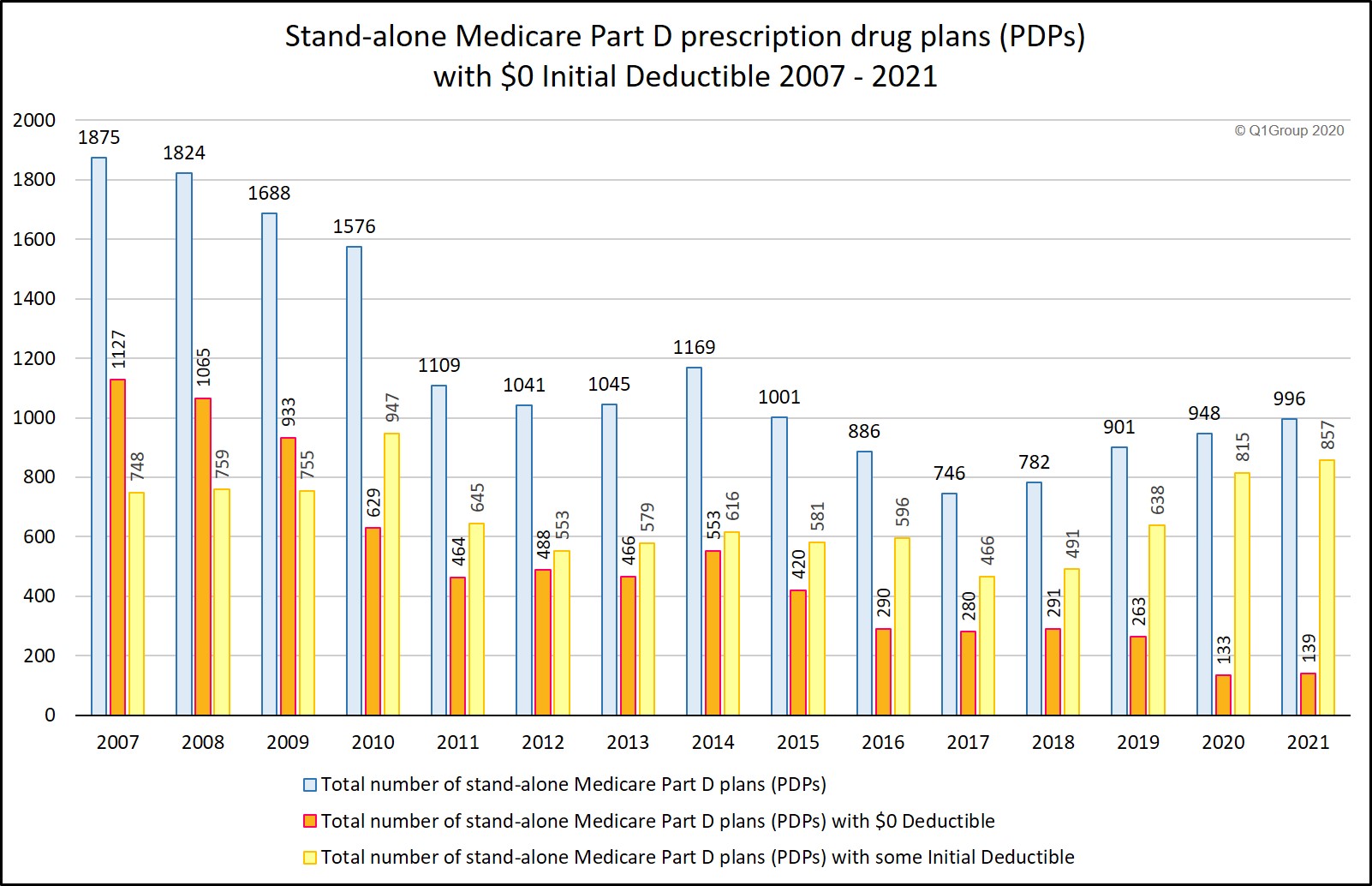About 86% of all 2021 stand-alone Medicare Part D prescription drug plans (PDPs)
will have an initial deductible ranging from $100 to $445 with the vast majority of these plans having a
$445 initial deductible.
Remember, you usually pay 100% of your initial deductible before your
Medicare Part D plan begins to provide coverage - but, see the exceptions below when a
Part D plan may exclude low-costing formulary Tiers from the deductible.
As background, the
standard CMS 2021 Medicare Part D plan
includes a $445 initial deductible and although a Medicare plan's initial deductible can
range from $0 to $445, most stand-alone 2021 Medicare Part D
prescription drug plans (PDPs) will use the CMS standard Medicare Part D plan deductible ($445).
Question: How many stand-alone 2021 Medicare Part D plans will have the $445
standard Initial Deductible?
Approximately 86%
of all 2021 stand-alone Medicare Part D plans (857 of the 996 PDPs) will have an
initial deductible -- ranging from $100 to $445. And, of all the 2021 PDPs having an
initial deductible, 78% will have the
standard deductible of $445
(665 of the 857 PDPs). **
As a state-specific example, of the 30 stand-alone 2021 Medicare Part D plans available
in Ohio, 26 plans will have an initial deductible ranging from $100 to $445, and
four (4) stand-alone Medicare Part D plans
will have a $0 initial deductible. You can see our
PDP-Facts.com/2021
for Medicare Part D premium information in your state.
Question: Are the $0 initial deductible stand-alone Medicare Part D plan losing favor?
Possibly. Based on our analysis of the 2021 PDP landscape data, only 14%
of all 2021 stand-alone
Medicare Part D plans will offer a $0 initial deductible. Although this 2021 percentage is the same for 2020 Medicare Part D plans, looking further back, this 14% of plans in 2021 compares
to 60% of 2007 PDPs having a $0 initial deductible**.
Here is a chart showing the changes of Medicare Part D plan designs since 2007 with fewer
Medicare Part D plans now offering a $0 initial deductible.

2021 Medicare Part D plans with some Formulary Drug Tiers excluded from the Initial Deductible
As was true in 2020, a number of stand-alone 2021 Medicare Part D plans having an initial
deductible will exclude some of their lower-costing formulary tiers from the initial deductible
and provide immediate coverage for these drugs, even though the initial deductible is not met.
For example, your Medicare Part D plan may have a $445 initial deductible,
but your Tier 1 and Tier 2 generic formulary drugs are excluded from the deductible,
meaning you do not need to pay the $445 before these lower-costing drugs receive coverage.
Editorial Comment: Having drug tiers exempted from the deductible
is a definite bonus for people using mostly low-costing
generic medications and who usually did not meet their initial deductible until almost the
end of the plan year. Now these people will have "first dollar coverage" for their
low-costing medications, plus the usual Medicare Part D coverage protection should
they need any expensive
brand or specialty medications costing well beyond the deductible.
For example, in 2020 the
Humana Walmart Rx Plan has a $435 initial deductible with Tier 1 and Tier 2 formulary
medications excluded from the deductible, now the 2021
Humana Walmart Rx Plan has a $445 deductible and we expect to see some formulary tiers excluded from the deductible (but, we will know more as the 2021 plan details are released).
Question: How does this work when certain drug tiers are not included in the plan's Initial Deductible?
If you are still within your $445 initial deductible
and purchase a medication such as Atorvastatin Calcium (generic Lipitor®), you would
not pay full retail price, but would instead be charged only a copayment
for this generic medication (when purchased at one of the Medicare Part D plan’s preferred
network pharmacy -- such as a Walmart pharmacy).
And
as always,
if your Medicare Part D plan’s cost-sharing is more than your drug’s retail price,
then you pay the lesser retail price (you never pay more than your negotiated retail price).
Reminder: Your Medicare plan costs and coverage can (and probably will) change
each year.
If you are interested in changing your Medicare plan enrollment, the annual Open Enrollment Period
(AEP) for Medicare Advantage plans and Medicare Part D drug plans begins
on October 15th and continues through December 7th, with your new 2021 Medicare Part D coverage starting on January 1, 2021.
Not sure where to begin?
If you or another Medicare beneficiary needs assistance understanding how your 2020 Medicare
plan is changing or to learn more about your 2021 Medicare plan coverage options,
please call 1-800-MEDICARE (1-800-633-4227) and speak with a Medicare representative.
- Sign-up for our Medicare Part D Newsletter.
- PDP-Facts: 2024 Medicare Part D plan Facts & Figures
- 2024 PDP-Finder: Medicare Part D (Drug Only) Plan Finder
- PDP-Compare: 2023/2024 Medicare Part D plan changes
- 2024 MA-Finder: Medicare Advantage Plan Finder
- MA plan changes 2023 to 2024
- Drug Finder: 2024 Medicare Part D drug search
- Formulary Browser: View any 2024 Medicare plan's drug list
- 2024 Browse Drugs By Letter
- Guide to 2023/2024 Mailings from CMS, Social Security and Plans
- Out-of-Pocket Cost Calculator
- Q1Medicare FAQs: Most Read and Newest Questions & Answers
- Q1Medicare News: Latest Articles
- 2025 Medicare Part D Reminder Service
